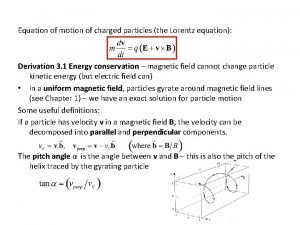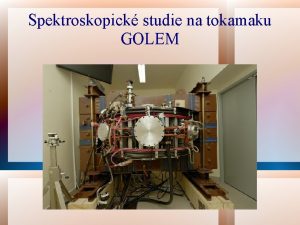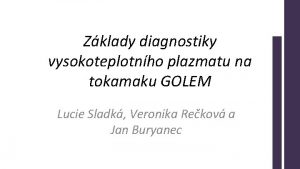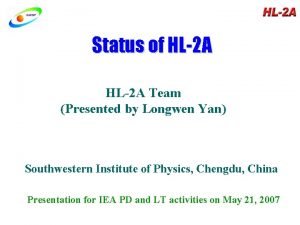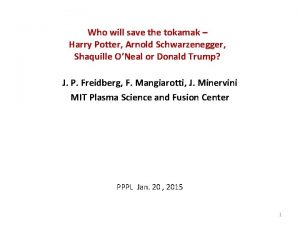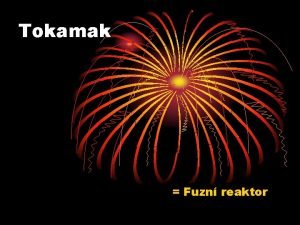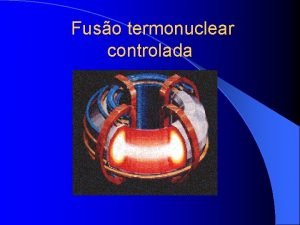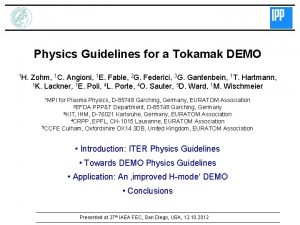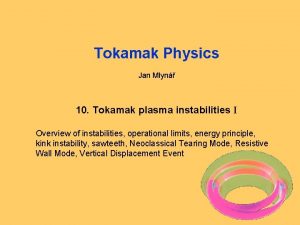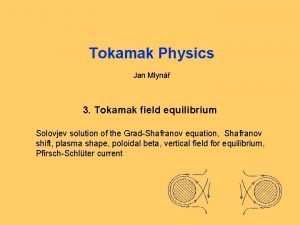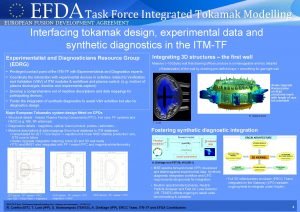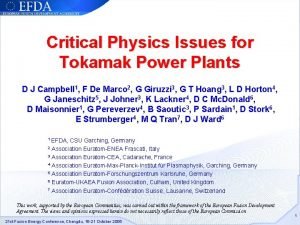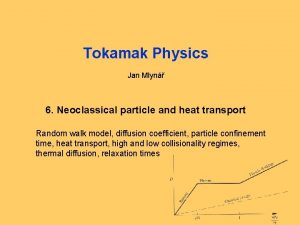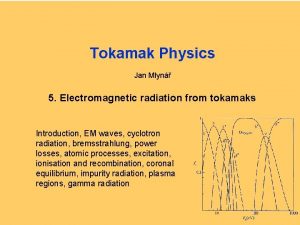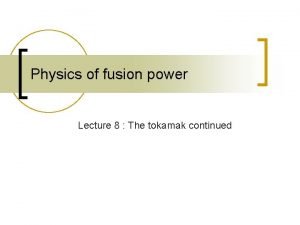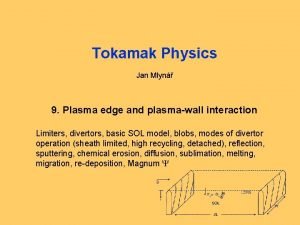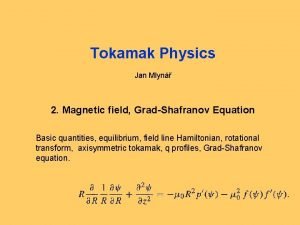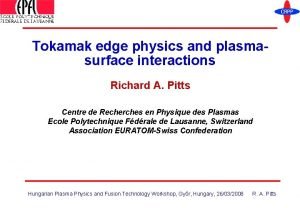Physics Guidelines for a Tokamak DEMO 1 H














![Heating and current drive in DEMO g [A/(Wm 2)] Remark LHCD ECCD FWCD NBCD Heating and current drive in DEMO g [A/(Wm 2)] Remark LHCD ECCD FWCD NBCD](https://slidetodoc.com/presentation_image/66c7e6249865f882e699648bc7e2bd70/image-15.jpg)





- Slides: 20

Physics Guidelines for a Tokamak DEMO 1 H. Zohm, 1 C. Angioni, 1 E. Fable, 2 G. Federici, 3 G. Gantenbein, 1 T. Hartmann, 1 K. Lackner, 1 E. Poli, 4 L. Porte, 4 O. Sauter, 5 D. Ward, 1 M. Wischmeier 1 MPI for Plasma Physics, D-85748 Garching, Germany, EURATOM Association 2 EFDA PPP&T Department, D-85748 Garching, Germany 3 KIT, IHM, D-76021 Karlsruhe, Germany, EURATOM Association 4 CRPP, EPFL, CH-1015 Lausanne, EURATOM Association 5 CCFE Culham, Oxfordshire OX 14 3 DB, United Kingdom, EURATOM Association • Introduction: ITER Physics Guidelines • Towards DEMO Physics Guidelines • Application: An ‚improved H-mode‘ DEMO • Conclusions Presented at 27 th IAEA FEC, San Diego, USA, 12. 10. 2012

Introduction – ITER Physics Guidelines ITER will address key issues for DEMO beyond present day experiments, the most prominent example being a-heating ITER design based on sound physics base, first outlined in ‘ITER Physics Design Guidelines’ and then augmented by the ‘ITER Physics Base’ The EU programme has identified ‘DEMO physics issues’ (items not needed for ITER Q=10, but absolutely vital for DEMO and an FPP) 1. Steady state tokamak operation ( DEMO 2 ITER) 2. High density operation (n/n. GW, DEMO 1) 3. Power exhaust (RDEMO/RITER = 1. 2, but PDEMO/PITER = 4) 4. Disruptions (WDEMO/WITER > 5) 5. Reliable control with minimum sensors and actuators In the following the ITER physics base is examined and updates are proposed related to the issues above (points 4 and 5 not covered today) N. B. : where needed, DEMO technology constraints into account, too

Areas examined in our work Area Issues Equilibrium Shaping vs. A MHD stability Fast particle effects on bmax, th, stability of fast particle driven modes Energy balance Transport at high b, n/n. GW and Prad, Te profile shape Particle balance Density profile shapes @ n/n. GW, impurity transport Power exhaust Detachment physics, lpower in detached divertor, other divertor concepts, ELM mitigation H&CD physics Full optimisation NBCD localisation Dynamical phases Realistic times for recharge Disruptions Timescales

Equilibrium A ~ 1. 5 A~2 A~3 A~5 Example: ‚natural‘ elongation k = 0. 5/(A-1) + 1 Adjusting for ITER geometry: k = 0. 5/(A-1) + 1. 5 li = 0. 5 li = 1 The physics of MHD equilibrium is well understood Plasma configuration has to be consistent with DEMO-like coil set • shaping and control will be more restricted than in present day devices • important for larger A and ‚new‘ divertor configurations • TF ripple should be considered consistently

Stability – limits to thermal b. N R. Buttery et al. , FEC 2008 N= /(I/a. B)=3. 5 DEMO (indicative) Ideal MHD limits well understood Resistive (NTM) stability important • Troyon scaling b. N, max = 4 li • conventional operational points will be metastable to NTMs • corrections for pressure peaking and active RWM control? • active avoidance/control (ECCD)?

Stability – limits to fast particle b stabilised by bounce modtion stabilised by precession drift Fast particle contribution is twofold NSTX, J. Berkery et al. , Phy. Rev. Lett (2010) • destabilisation of otherwards stable modes (XAEs, EPMs) • orbit effects can stabilise global MHD modes (example: RWM) Depends on subtleties of profiles / nonlinear saturation – can trends be captured by 0 -d fits?

Particle transport – density profiles Angioni et al. 2003 AUG Initial ITER assumption: density profiles are flat at n~n. GW Recent finding: peaking depends on neff rather than n/n. GW • proposal: density limit applies to ne, ped/n. GW (< 1) • calculate density peaking from first principles (include also b!)

Particle transport – density profiles n (1019 m-3) ITER, low b ASDEX Upgrade pellet fuelling r (m) G. Pereverzev et al NF 2005 P. T. Lang et al. , this conference Initial ITER assumption: density profiles are flat at n~n. GW Recent finding: peaking depends on neff rather than n/n. GW • proposal: density limit applies to ne, ped/n. GW (< 1) • calculate density peaking from first principles (include also b!)

Heat transport: validity of IPB 98(y, 2) DEMO ITER Due to the higher b. N, n/n. GW and Prad, core (see later), IPB 98(y, 2) not necessarily valid for DEMO

Heat transport: validity of IPB 98(y, 2) A. Kallenbach et al. , this conference Same dataset, normalised to: Kardaun 2006 IPB 98(y, 2) AUG C-Mod JET (but note n*, r* variation) • H-mode confinement tends to increase with higher b. N (IPB 98: ~ b-0. 9) • H-mode confinement tends to decrease with higher n/n. GW (IPB 98: n 0. 4) • in addition, not clear how to correct for highly radiating discharges This should be addressed, based on our increasing physics understanding

Exhaust of power through a divertor in DEMO T. Eich et al. Phys. Rev. Lett. 2011 Technology limit stricter than in ITER (high n-fluence): Ptarget ≤ 5 MW/m 2 Under attached conditions, no R-scaling of lq • expect 1 -2 mm in midplane, 1 -2 cm at the target 200 MW/m 2 • need to (partially) detach divertor and add substantial radiative losses

Exhaust of power through a divertor in DEMO Technology limit stricter than in ITER (high n-fluence): Ptarget ≤ 5 MW/m 2 Under attached conditions, no R-scaling of lq • expect 1 -2 mm in midplane, 1 -2 cm at the target 200 MW/m 2 • need to (partially) detach divertor and add substantial radiative losses

Design guidelines for power exhaust in DEMO Long term: develop predictive capability for divertor detachment Interim solution: use Psep/R divertor scaling together with Psep>PHL: • Lower bound: ASDEX Upgrade result: Psep / R = 7 MW/m • Upper bound: ITER assumption: Psep /R = 15 MW/m An unprecedented ‚core‘ radiation level will be needed in DEMO! • Prad(r) must be tailored consistent with confinement needs N. B. : we are also missing quantitative guide lines for the first wall load!

Double Radiation Feedback on ASDEX Upgrade A. Kallenbach, subm. to Nucl. Fusion Prad, main controlled by Ar-seeding, Tdiv controlled by N-seeding • Pheat, tot = 23 MW, but qdiv < 5 MW/m 2 and Prad, core = 15 MW (67%) • close to Pthres, but still H=1 and N = 3!
![Heating and current drive in DEMO g AWm 2 Remark LHCD ECCD FWCD NBCD Heating and current drive in DEMO g [A/(Wm 2)] Remark LHCD ECCD FWCD NBCD](https://slidetodoc.com/presentation_image/66c7e6249865f882e699648bc7e2bd70/image-15.jpg)
Heating and current drive in DEMO g [A/(Wm 2)] Remark LHCD ECCD FWCD NBCD 0. 3 -0. 4 0. 1 -0. 2 ≤ 0. 1 0. 3 -0. 4 (indep. of Te) (ITER prediction) very peripheral absorption potential for optimisation (next slides) small exp. Basis off-axis CD not fully understood Physics is relatively well understood, but efficiencies can be improved w. r. t. ITER by a targeted optimisation, trading off flexibility

Example: Optimisation of ECCD for DEMO E. Poli et al. , subm. to Nucl. Fusion Higher f. ECCD gives higher g. CD, limited by parasitic 2 nd harmonic absorption This can be circumvented by using top launch!

Results for top launch (here, f. ECCD = 230 GHz) Efficiency g. CD Toroidal launch angle Deposition radius Poloidal launch angle Increasing f. ECCD, on-axis CD efficiency can go up to g. CD = 0. 4 (!) • launch position must be optimised for each desired CD position • then, current drive efficiencies come close to values for NBCD!

First studies on an ‘improved H-mode’ DEMO R=8. 5 m a =2. 84 m B=5. 75 T Ip = 17. 6 MA q 95=4 b. N = 3, Pfus=2. 2 GW fbs ~ 0. 5 G. Tardini (IPP) Based on ASDEX Upgrade profile shapes with peaked density • for frec = 0. 4, need to drive 8. 8 MA with 150 MW (g. CD = 0. 5) at h. CD = 0. 5 Tough constraint on overall efficiency h. CDg. CD, but in reach for NBCD/ECCD!

The ‘ITER’ case: R 0=7. 5 m, Bt=5. 2 T, A=3. 1 Improved technology and physics (h. CD=0. 5, g. CD=0. 4, H=1. 2, b. N = 3. 5) * b. N = 3. 5 tpulse = 8 hrs frec = 37% Pel, net = 500 MW H. Zohm, Fus. Sci. Technology (2011) Long pulses in reach, but achieving steady state challenging stability limits… pulsed and steady state options to be studied in parallel (different A!)! high efficiency of H&CD systems becomes crucial!

Conclusions Area Issues Color code Equilibrium Shaping vs. A MHD stability Fast particle effects on bmax, th, stability of fast particle driven modes Sound physics base Energy balance Transport at high b, n/n. GW and Prad, Te profile shape Particle balance Density profile shapes @ n/n. GW, impurity transport Power exhaust Detachment physics, lpower in detached divertor, other divertor concepts, ELM mitigation H&CD physics Full optimisation NBCD localisation Dynamical phases Realistic times for recharge Disruptions Timescales Restricted applicability Major progress needed Target: agree on DEMO Physics Guidelines across parties
 Tokamak működése
Tokamak működése Tokamak
Tokamak Tokamak golem
Tokamak golem Tokamak
Tokamak Hl2 tokamak
Hl2 tokamak Harry potter arnold
Harry potter arnold Hl2m tokamak
Hl2m tokamak Tokamak schéma
Tokamak schéma Tokamak
Tokamak University physics with modern physics fifteenth edition
University physics with modern physics fifteenth edition Physics ib ia ideas
Physics ib ia ideas Modern physics vs classical physics
Modern physics vs classical physics Inköpsprocessen steg för steg
Inköpsprocessen steg för steg Borra hål för knoppar
Borra hål för knoppar Mat för idrottare
Mat för idrottare Strategi för svensk viltförvaltning
Strategi för svensk viltförvaltning Vad är ett minoritetsspråk
Vad är ett minoritetsspråk Svenskt ramverk för digital samverkan
Svenskt ramverk för digital samverkan Datorkunskap för nybörjare
Datorkunskap för nybörjare Rita perspektiv
Rita perspektiv Läkarutlåtande för livränta
Läkarutlåtande för livränta

